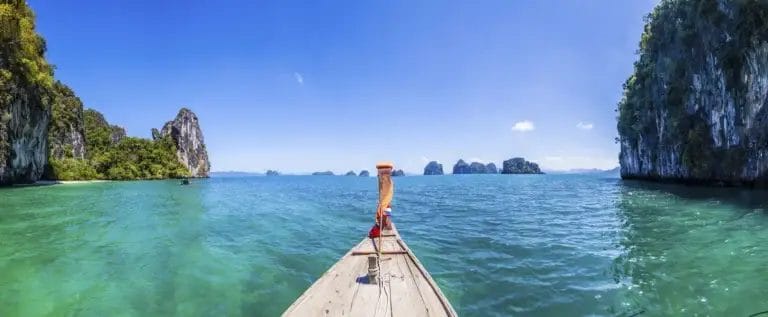
What is Phang Nga Bay?
Phang Nga possesses a remarkable landscape adorned with mountains and forests. It is a province celebrated for its breathtaking landscape, bay, and stunning islands. Its national parks showcase magnificent scenery and diverse attractions.
Among them, Phang Nga Bay National Park stands out as a geological wonder, teeming with islets, sunken caverns, and awe-inspiring rock formations rising dramatically from the sea. The bay offers ideal conditions for sea kayaking expeditions, allowing explorers to venture into fascinating caverns and islands scattered throughout the area.
Along Phang Nga’s Andaman coast, equally stunning national parks of a different kind can be found. Surin and Similan Island groups are famous for their pristine beaches and spectacular underwater scenery, attracting divers from around the globe. The bay is also an extraordinary destination for sailing enthusiasts.

Its stunning limestone bluffs create a picturesque backdrop, and numerous sheltered spots allow for peaceful anchoring. The bay’s protection from the Northeast and Southwest monsoon seasons ensures calm waters throughout the year, enhancing the appeal of its natural wonders and abundant wildlife.
Its prominent feature is Khao Chang, a majestic mountain resembling a crouching elephant, symbolizing the province of Phang Nga. Explorers can venture into the enchanting Ruesi Sawan cave and Luk Suea cave within Somdet Phra Sri Nakarin Park, along Khao Chang Road.
Inside these caves, visitors are greeted with a refreshing coolness, clear streams, and stunning stalagmites and stalactites. Another tranquil spot is Pung Chang Cave, adorned with exquisite formations and a perennial stream.
Moreover, the bay boasts enchanting islands awaiting travelers to experience their allure. Notably, North Surin Island and South Surin Island are renowned for their charming bays, with Aow Mae Yai standing out as the most well-known, characterized by its expansive and gentle sea.
Also, groups of farm women craft famous products such as artificial flowers made from rubber tree leaves. Local stores and markets around the city offer dried seafood and shrimp paste for purchase.
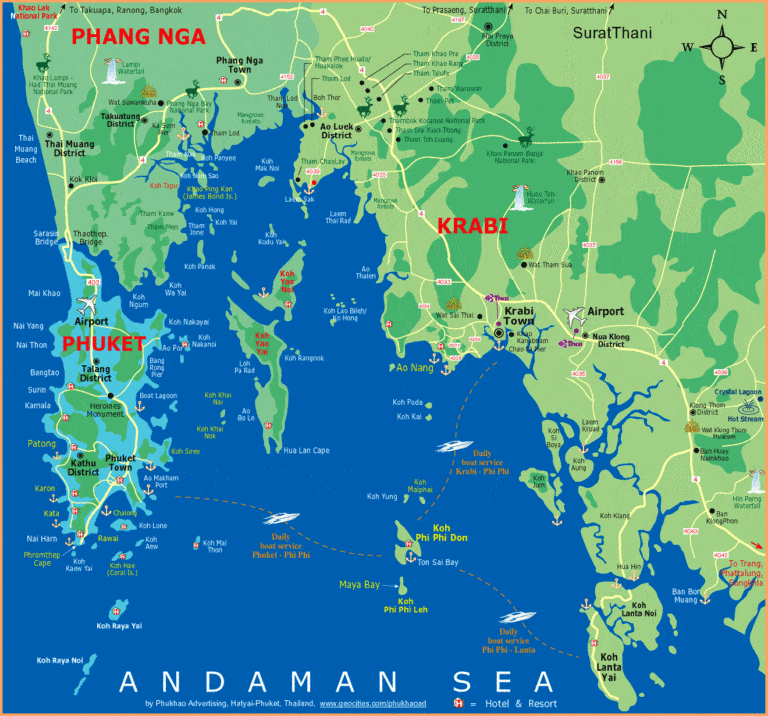
Where is Phang Nga Bay?
Located in the northern section of the Malacca Strait, nestled between the stunning island of Phuket and the provinces of Phang Nga and Krabi on the southern mainland of Thailand, lies Phang Nga Bay. Encompassing a sprawling area spanning 249 square miles, this spectacular bay is home to numerous natural wonders.
The magnificence of this region is safeguarded by the Ao Phang Nga National Park, situated in Phang Nga province, which acts as a shield for a significant portion of the bay.
Within this archipelago, consisting of more than 40 islands, most of which remain uninhabited, two islands stand out as the most populous. These are Ko Yao Yai, also known as Big Long Island, and Ko Yao Noi, referred to as Small Long Island. These two islands captivate visitors with their enchanting charm and provide a glimpse into the vibrant island life of Thailand. It’s worth noting that “Ko” can alternatively be spelled as “Koh” and translates to “island” in Thai.
Why should you go to Phang Nga Bay?
Phang Nga Bay attracts many visitors who often stumble upon its mesmerizing beauty without even realizing it. This enchanting destination is renowned for its boat trips that take you through the breathtaking bay, most notably recognized for its association with James Bond Island.

Accessible from Phuket, Krabi, and other southern regions, these boat excursions offer an opportunity to marvel at the stunning bay and explore the numerous captivating attractions that make Phang Nga worth adding to your Southern Thailand itinerary.
Situated in the southern region of Thailand near the popular tourist destination of Phuket, the bay boasts magnificent beaches and a wealth of thrilling cultural attractions. While Phuket has garnered global recognition, Phang Nga Province has offerings for visitors seeking an unforgettable experience.
Here are some reasons you should have Phang Nga Bay on your bucket list for your trip to Thailand:
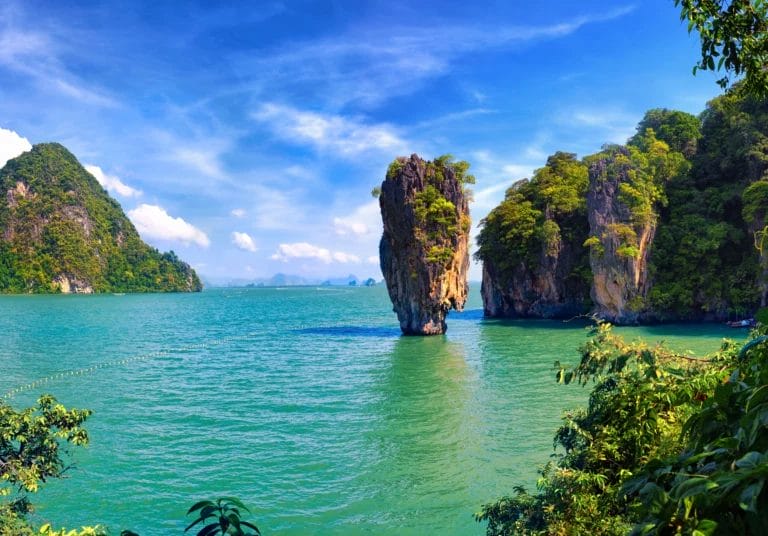
James Bond Island
James Bond Island, officially known as Koh Tapu and its neighboring pinnacle Koh Ping Ghan, stands out as some of Thailand’s most revered destinations. The breathtaking natural wonders have likely caught your eye through postcards, travel websites, and promotional materials.
The stunning limestone island boasts a striking sheer wall that gained fame in the Bond film, “The Man with the Golden Gun.”
Its allure draws countless visitors year-round, captivated by the shimmering emerald waters surrounding the island. Peering into the depths, one can often catch glimpses of small fish swimming near the shore, enhancing the magical ambiance.
Additionally, numerous hidden caves and secluded spots are waiting to be explored.
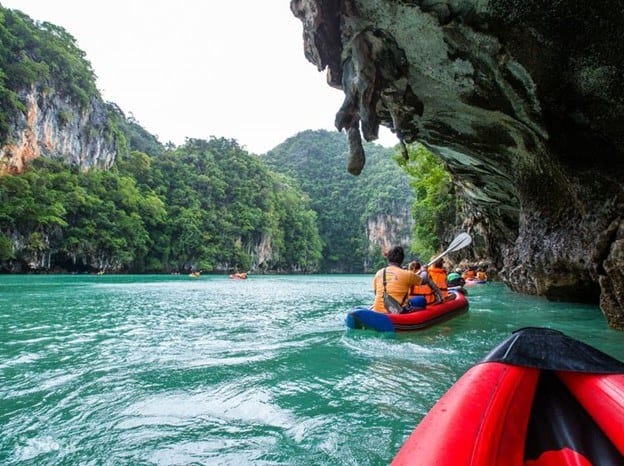
Panak Island
Panak Island, situated in Ao Nang Bay, stands as one of the larger islands in the area. This captivating island offers a range of activities, including canoeing, swimming, cave exploration, and the opportunity to observe wildlife.
Panak Island boasts an impressive collection of at least 11 notable caves, most located at the island’s northern tip. Some of these caves are easily accessible, and a few even sit at sea level. Numerous enchanting lagoons can be reached within the island by canoeing through certain caves.
Moreover, the island is home to a lively population of monkeys known for their swimming skills and ability to catch crabs. Over time, Panak Island formed from sedimentary layers on the bottom of a tropical ocean devoid of any volcanic activity.
As a result, the rock on the island is relatively soft, and limestone and minerals slowly ooze over time. The scenery surrounding the island is genuinely awe-inspiring, adorned with magnificent cliffs and stunning stalactites.

Ice Cream Cave
Popularly referred to as Koh Nat, this cave stretches an impressive 120 meters in length and can be found at the northern tip of a petite shoreline on the northeastern coast of Koh Phanak Island.
The cave comprises a solitary sub-horizontal passage, positioned approximately 5 meters above sea level, culminating in an inviting open-air lake known as a lagoon.
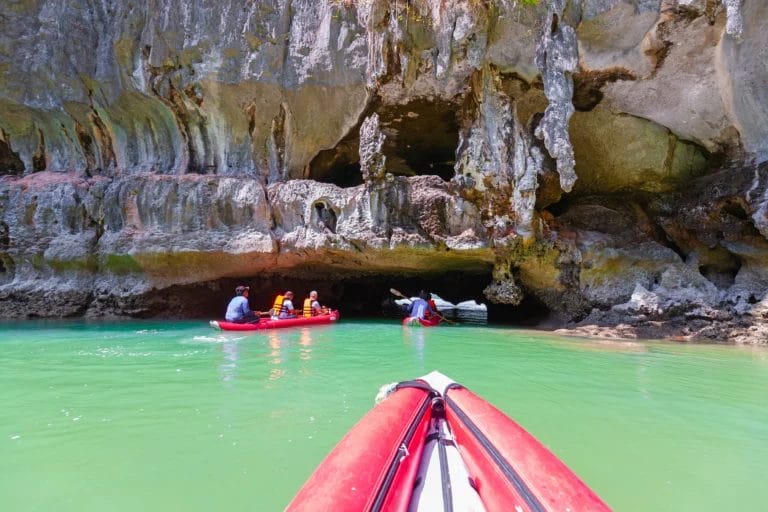
Panak Cave
Known locally as Tham Panak, Koh Panak Cave stretches over 253 meters, featuring narrow passages that wind through its interior. This beautiful cave awaits exploration, situated at the southern tip of the small beach that Ice Cream Cave occupies.
Diamond Cave
Diamond Cave, also called Tham Phet in the local area, is a beautiful underground cavern along the eastern shoreline of Panak Island, a short distance south of Panak Cave. Spanning approximately 70 meters, this captivating cave formation lies at sea level, awaiting exploration and discovery.
Oyster Cave
Oyster Cave, referred to as Tham Man Hoi or Tham Hoy Naan Rom by the locals, is a stunning sea cave that spans approximately 50 meters long. It serves as a passage leading to a beautiful smaller lagoon. Positioned in the northwestern region of Panak Island, this cave offers an enchanting exploration experience.
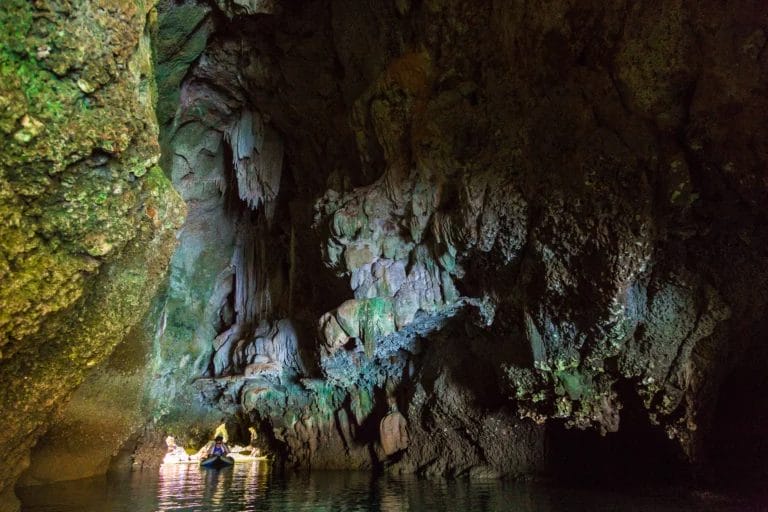
Khang Khao Cave
Bat Cave or Tham Khang Khao in Thai can be found farther south of Oyster Cave on the west coast of Panak Island. This remarkable cave stretches 150 meters and leads to a beautiful sea-level lagoon. Khang Khao Cave, or Bat Cave, is perched 50 meters high on a small mountain within the Pha Phu Man National Park area.
It offers a mesmerizing spectacle during the early dawn and evening as thousands of bats depart or return to their dwelling.
As a popular tourist destination, the cave provides amenities like benches and chairs for sightseeing and food and beverage options. Nestled amidst the Rocky Mountains, Khang Khao Cave is surrounded by diverse plants and trees, creating a breathtaking natural environment
Mangrove Cave
Mangrove Cave, also called Tham Pa Chai Len by locals, is a captivating sea-level cave passage extending for 100 meters, leading to a serene lagoon. This cave offers an intriguing adventure on the northeastern side of Panak Island.
Visitors can embark on a long-tail boat journey to reach the caverns and navigate the enchanting channels that weave through the mangrove forests.
Within the cave, a myriad of captivating formations adorn the cavern walls, including stalactites and stalagmites. Adding to the allure, several caverns serve as habitats for colonies of bats, contributing to the unique ecosystem of this remarkable destination.

Hong Island
Koh Hong, renowned for its exceptional canoeing opportunities in Phang-Nga Bay, stands as the second most sought-after destination among the islands. Its allure lies in the remarkable sea-level cave passage leading to a stunning lagoon.
Additionally, the surrounding area boasts numerous smaller limestone karts and islands adorned with lush forests, offering enchanting and striking narrow canoeing passages.

Lot Nai Cave
Lot Nai Cave is situated amidst the beautiful mangrove forests on the mainland. This stunning cave spans 110 meters and is positioned at the convergence point where a river gracefully slices through a limestone island. It rests close to the headquarters area yet remains secluded, reachable solely by boat.
Nestled at sea level, the cave welcomes adventurers with a spacious passage that stretches 40 meters wide, allowing boats to navigate its depths. Within its enchanting confines, the cave proudly showcases a multitude of exquisite decorations, adding to its allure.
Nak Cave
Nak Cave, renowned for its captivating rock paintings, can be found south of Lot Nai Cave and west of Koh Panyi, nestled on a limestone hill alongside a flowing river. Stretching approximately 50 meters long, this cave features a vast opening—a magnificent aperture in the cave ceiling—granting access to a lush mangrove swamp.
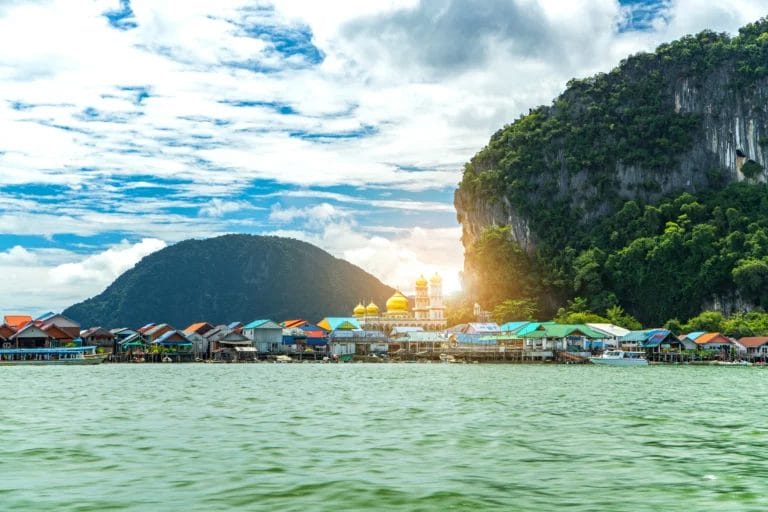
Koh Panyi
Koh Panyi, although located within the national park’s boundaries, is not officially governed by the park authorities, and is not considered a part of the national park itself.
However, it remains a trendy and well-visited island, known for its closely built houses standing on pillars rising from the sea or on the island itself. The northern end of the island boasts a striking limestone karst formation.
Additionally, visitors can arrange trips to explore the various attractions of the entire park from Koh Panyi. The island offers amenities such as hotels, shops, and restaurants.
One of the prominent features of Koh Panyi is a prominent limestone mountain with a distinctive peak. This mountain serves as a natural barrier, protecting the area from the force of the ocean waves.
Adjacent to it lies a substantial sandbank that has evolved into a settlement, comprising four small villages enveloped by breathtaking natural beauty, including serene mangrove forests and the numerous islands of Phang-Nga National Marine Park.
The ancestors of the island’s present inhabitants can be traced back to three Javanese families who embarked on a voyage from Indonesia to Thailand’s Andaman coast at the close of the 18th century.
When is the best time to visit Phang Nga Bay?
Thailand experiences two distinct seasons: the monsoon season, which occurs from May to October, and the dry season, which lasts from mid-October to April.
From mid-October to mid-April, the weather in Thailand is characterized by clear skies and abundant sunshine. Rainfall is minimal, and the overall climate is cooler and less humid, especially in December and January.
However, this timeframe is also the peak season for tourists flocking to the pristine waters and beaches of Phang Nga Bay. To avoid crowds, it is advisable to visit the bay early in the morning or later in the evening.
Alternatively, you can expect fewer tourists if you can visit Phang Nga between May and October, which is the monsoon season. However, you should be prepared for frequent rain showers and high humidity during this period.
How to get to Phang Nga Bay?
The bay is conveniently served by two nearby airports in Krabi or Phuket, both of which serve as an excellent starting point for exploring the beautiful Phang Nga province.
Alternatively, you can stay in Khao Lak, a village in Phang Nga, where you’ll be treated to stunning powdery white beaches and easy access to boat day trips that take you to enchanting islands and lush rainforests. Getting to the park headquarters area is relatively straightforward, whether you choose public or private transport.
However, the immediate surroundings offer limited attractions, mainly comprising a few short trails for birdwatching. If you aim to embark on a personalized journey into the park by renting a private boat, that option is available.
But for most visitors, booking a tour through various reputable operators or agencies is highly recommended for a more comprehensive and enjoyable exploration of the islands.
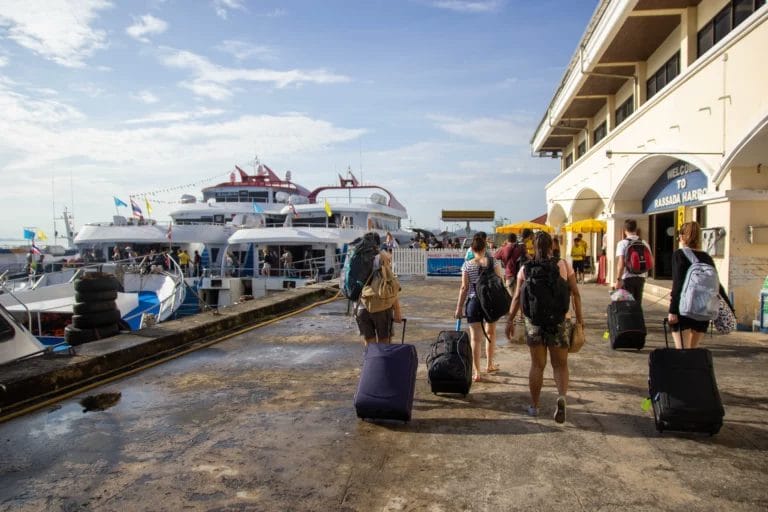
• Khlong Khien Pier
This pier is in the Takua Thung District of Phang-Nga Province. It is the closest pier to the park north of Phuket Island. Accessible by car from neighboring towns.
• Rassada Pier
Located east of Phuket Town, Rassada Pier serves as the primary pier on Phuket Island.
• Nopparat Thara Pier
Located northwest of Nopparat Thara Beach in Ao Nang, Krabi.
• Floating Pier, Railay
Found on the eastern side of Railay Bay.
• Khlong Jirad Pier
Positioned south of Krabi City.







6 Responses
I am currently planning my first visit to Thailand and find this to be a very detailed and informative post on the beautiful Phang Nga Bay. With the numerous natural wonders, it certainly looks like a stunning area, full of splendour and attractions.
With all the islands and hidden caves, I will certainly include Phang Nga Bay in my itinerary. Thank you for sharing this delightful destination.
Hi LineCowley,
That’s wonderful to hear that you found my article helpful in planning your visit to Thailand and exploring Phang Nga Bay! It truly is a breathtaking destination with its stunning natural wonders and hidden treasures.
When you visit, I highly recommend considering booking a tour activity to fully experience all that Phang Nga Bay has to offer. A guided tour can help you uncover hidden caves, navigate the islands safely, and provide insightful information about the area’s rich history and ecology. Plus, it can make your visit more convenient and enjoyable, allowing you to focus on soaking in the splendor of this remarkable place.
You can find tour options available on my website, where I’ve curated links to trusted platforms like GetYourGuide.com and Expedia.com. Be sure to choose a tour with high ratings and reviews to ensure a memorable and enjoyable experience.
Once again, thank you for your comment, and I hope you have an incredible time exploring Phang Nga Bay! If you have any further questions or need additional recommendations, feel free to reach out. Wish you a safe and wonderful trip to Thailand! (:
Benjamas
Hi Benjamas,
Your detailed post on Phang Nga Bay absolutely transported me! Reading about the stunning limestone cliffs, mysterious caves, and the tranquil waters of the bay makes me eager to explore it myself. It sounds like a perfect adventure with its natural beauty and exciting kayaking opportunities. I’ve always been fascinated by the sheer variety of experiences one can have in Thailand, and your article just adds to that charm. Have you had the chance to explore any of the caves yourself? If so, which one was your favorite?
Thank you for your work and for sharing this beautiful destination with us.
Best regards,
Makhsud
Hi Makhsud,
Thank you so much for your kind words! I’m glad to hear that my post on Phang Nga Bay sparked your interest in exploring this stunning destination.
It truly is a breathtaking destination! The combination of towering limestone cliffs, hidden caves, and serene waters makes it a perfect destination for adventure and nature lovers. Exploring the caves in Phang Nha Bay is definitely fun and challenging! Unfortunately, I didn’t get the chance to visit them.
If you ever find yourself planning a trip to Thailand, I highly recommend adding Phang Nga Bay to your itinerary, and thank you so much again!
Best regards,
Benjamas
Hey Benjamas
I just finished reading your blog post about Phang Nga Bay, and I must say, WOW! The stunning limestone cliffs, crystal-clear waters, and hidden caves truly make it a natural wonder. Your article perfectly captured the beauty and serenity of this breathtaking destination. I can’t wait to experience it for myself. Thank you for sharing this incredible adventure!
Marios
Hi Mario,
Thank you so much! I’m glad to hear that you enjoyed my article about Phang Nga Bay. It truly is a mesmerizing destination with its stunning limestone cliffs, clear waters, and hidden caves. I hope my article inspired you to plan your own adventure there!
Thank you again!
Benjamas